If you are from sales or marketing, you must have often encountered terms like lead, prospect, opportunity, and more.
Although these terms are used interchangeably in blogs, literature, whitepapers, etc., they have different meanings in a business context.
We will help you understand lead and opportunity management better and highlight the difference between them.
Let us start with lead management, but first, a quick look at the lead stages.
In general, the stages of leads look like this:
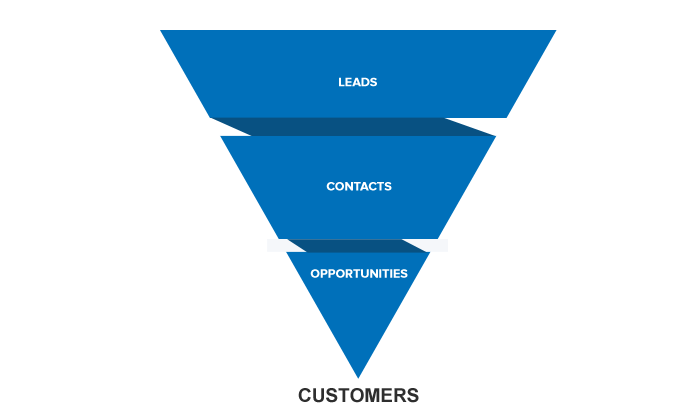
- Lead: A lead is an individual (or organization) that has shown interest in your product/service/content by sharing his contact information.
- Prospect: A prospect is a lead who has been qualified for sales by a company based on its business offerings.
- Opportunity: A sales opportunity is an individual who has a high chance of becoming a customer. It also refers to the potential up-selling/cross-selling opportunities to an existing customer.
- Customer: When an individual buys your product/service, he becomes a customer.
Even though a lead and an opportunity are both potential buyers, they are different in numerous ways. Moreover, lead management may sound similar to opportunity management, but they are not the same. Let us understand this in detail.
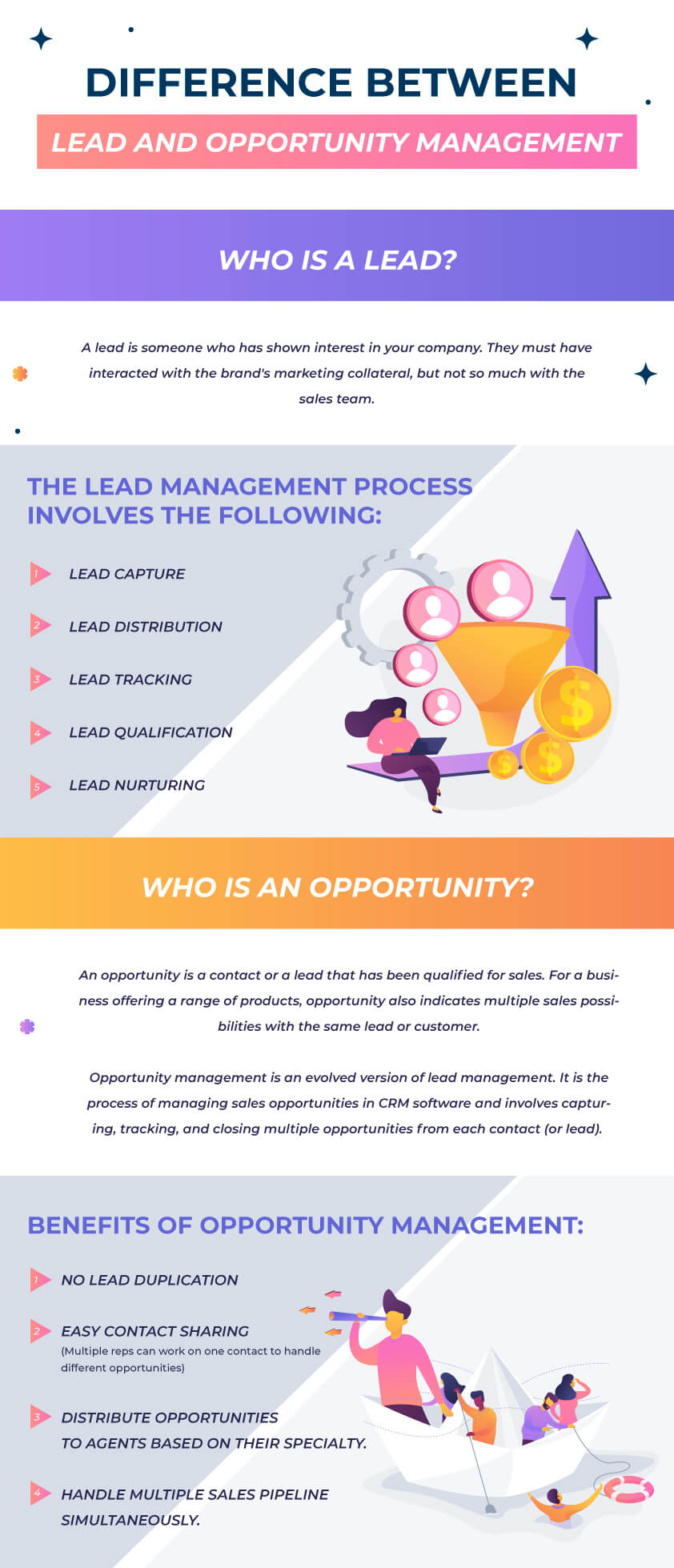
What is Lead Management?
Lead management is the process of capturing leads, tracking them, nurturing them, and making sure that they get interested in your company/product/service. Companies generally use lead management software or CRM software for end-to-end lead management.
Who is a lead?
A lead is someone who has shown interest in your company. They must have interacted with the brand’s marketing collateral, but not so much with the sales team.
For instance, a person who saw your product on social media, visited your website, and dropped an inquiry could be a lead. A lead could also be an individual who clicked an ad on a website, saw your landing page, and subscribed to your newsletter. It could also be someone who commented on your social media page or started a chat. The point is – when someone reaches out to you, you get their contact information. And this is how you find a lead.
However, there is no guarantee that this person will stay interested in your brand in the future. All you have is the contact details of an individual who has shown some degree of interest in your offering. When you start a business, and start investing in lead generation, leads will start pouring in through every direction – from social media, online advertisements, website visits, referrals, phone calls, and more.
These people become a part of your sales pipeline. However, only a handful of them will end up buying. But, to maximize conversions, you need to ensure that your leads do not lose interest in your brand. This process of capturing leads and keeping them engaged is lead management.
On a high level, lead management involves steps like lead capture, tracking interactions with leads, lead distribution, lead qualification, and lead nurturing. Let us understand these steps.
The steps involved in a lead management process
- Lead capture: Lead capture refers to the process of entering the details of the lead into the system, either automatically from different channels or manually. The details include the name and contact information, lead source, demographics, interest, occupation, and more. The more data you have about a lead, the better you can cater to them. You can understand what they are looking for and how you can help them.
- Lead distribution: Lead distribution is assigning the leads to the relevant salespeople for follow-up and future interactions. The distribution criteria can be location, product interested, availability of the sales reps, etc.
- Lead tracking: Lead tracking allows you to understand how a lead is interacting with your brand. You can gauge the interest level by looking at the pages they have visited on your website or how much time they spend on the blog, etc.
- Lead qualification: Lead qualification is the process of evaluating leads based on specific criteria. For instance, you can assign scores based on their activities on your website, such as pages visited, email opened, and links clicked. You can also define quality scores. For instance, you can select certain attributes and assign weightage to them to determine the quality score. Lead scoring allows sales reps to understand which lead is worth nurturing.
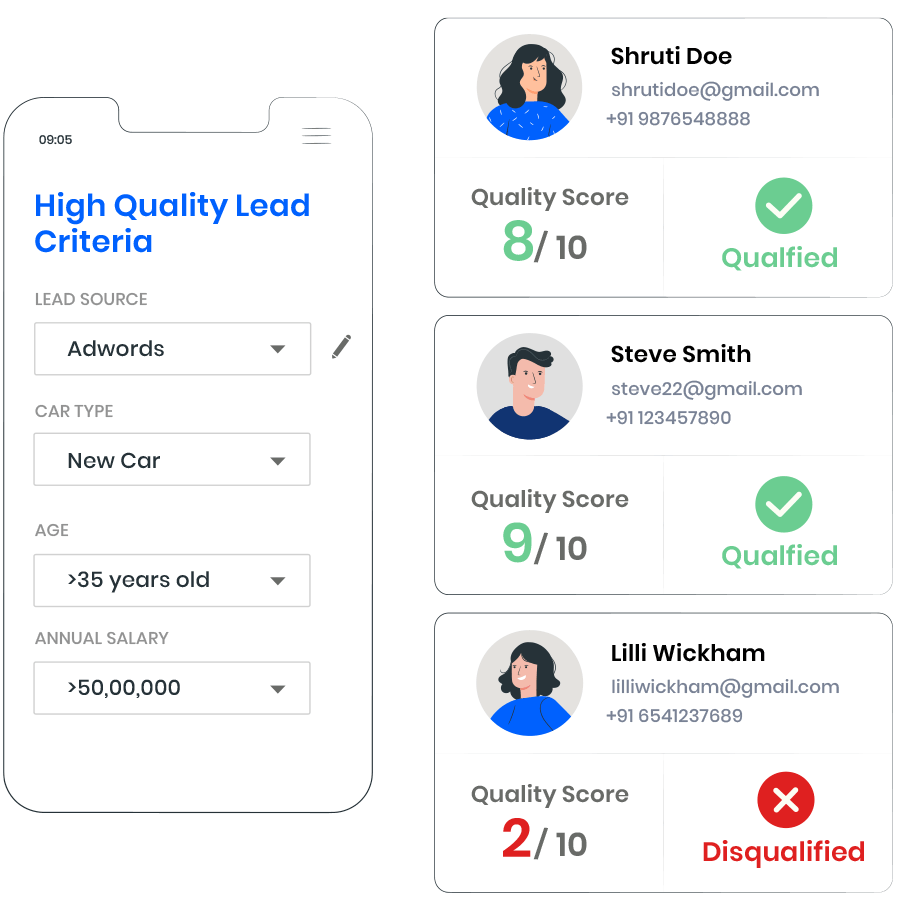
- Lead nurturing: Lead nurturing is the process of developing and reinforcing relationships with buyers. At this point, the marketing team reaches out to the lead through email campaigns, social media, or other channels to get them interested in the product.
How CRM helps in lead management?
You can automate all of these steps of lead management using CRM software. A CRM can automatically capture leads from different sources while preventing duplication. It can also track leads and log all activities. Next, it can assign leads to sales reps based on specified criteria. The CRM system can also send notifications to the sales reps whenever there is an update in the lead activities. Further, CRMs assist in the sales process by automated lead nurturing process and drip email campaigns.
Let us now explore opportunity management.
What is opportunity management?
Opportunity management is the process of managing sales opportunities in CRM software. It involves capturing, tracking, and closing multiple opportunities from each contact (or lead). Opportunity management helps you manage multiple products and spot upsell/cross-sell opportunities to increase your CLV (Customer Lifetime Value).
To understand it better, let us define the term “opportunity” first.
Who is an Opportunity?
Opportunity usually refers to a sales opportunity. A sales opportunity is an individual who has a high chance of becoming a customer. In other words, they have a problem that you are capable of solving with your offering. They are ready to make the purchase and have the budget for it. Now, it is up to the salespeople to close the deal.
In more formal terms, a sales opportunity is a qualified prospect. Typically, only 10 to 15% of B2B sales opportunities become deals. Hence, a business must set up clear criteria to qualify an individual as a sales opportunity. These criteria or the set of requirements laid by the companies create the sales pipeline.
What is a sales pipeline?
A sales pipeline is a set of stages that an individual passes through during the purchasing process. It is an intuitive way to visualize your potential buyers and understand where they are. A sales pipeline has different stages, and the buyer must satisfy some criteria to progress from one phase to the next. These criteria could be something like subscribing to newsletters, downloading a whitepaper, or booking a demo. These show how interested an individual is in the brand. So, a sales opportunity is someone who has advanced through multiple stages and is now in the penultimate stage, right before closing the deal.
Now, going back to the main question – what is opportunity management? Opportunity management is a set of methodologies for tracking and managing your opportunities. Opportunity management requires you to have a well-defined sales pipeline. That is, segment buyers into different categories, one of which is your sales opportunities. Your sales reps will be responsible for handling these opportunities.
When it comes to opportunity management, a CRM software is an indispensable tool. Each sales rep may have a different idea of what an opportunity means. With CRM, you can define various stages of the pipeline and set up rules for progressing through them. This structure adds consistency to the sales process, and everyone on the sales team will have a clear idea of what to do next.
The modern-day CRMs help organizations manage multiple opportunities with the same buyer. For instance, your health insurance customer could be interested in car insurance and term insurance as well. Thus, the scope of opportunity management is not limited to one opportunity. It also deals with multiple opportunities with the same customer.
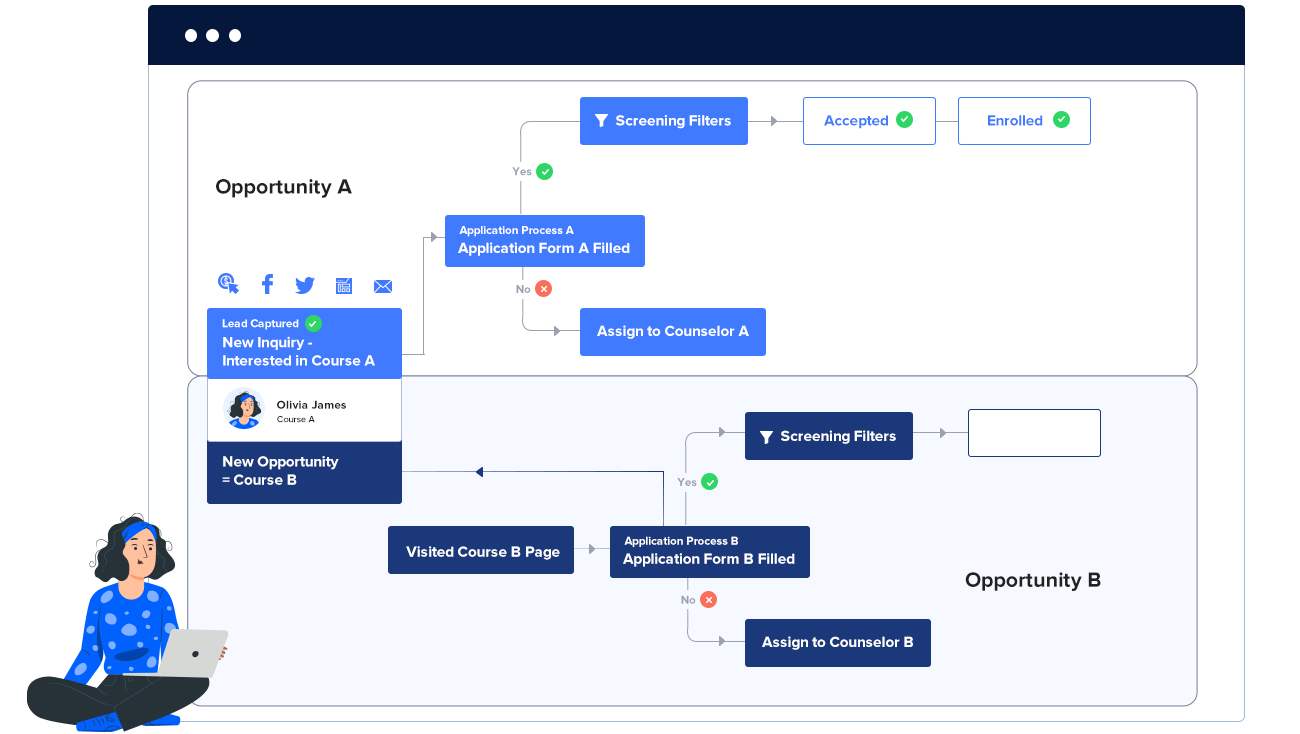
What is the difference between lead management and opportunity management?
Opportunity management and lead management may seem like similar tasks. But there are fundamental differences in the processes. In lead management, you focus on nurturing the leads and develop an interest in your offering. In sales opportunity management, you focus on those individuals who are nearly ready for the deal.
Opportunity management is an evolved version of lead management.
Lead management is a preliminary stage where you try to get an individual interested in your brand. Opportunity management is the later stage where you have interested leads, and they are ready to make the purchase. Here, you negotiate with them and try to close the deal.
Lead management is of interest both to the marketing team as well as the sales team. The marketing team needs to know your leads to design effective marketing campaigns that will improve the ROI. The sales team will have to link those leads to opportunity management to build relationships and generate more revenues.
Lead and opportunity management in CRM
CRM software brings lead management and opportunity management under the same roof. It provides a unified interface for managing the entire sales pipeline. Here, you can see the number of leads, opportunities, and customers. You can also see how many leads become opportunities and how many opportunities convert into sales, and in what time-frame.
A CRM will automatically capture leads, score them, distribute, and nurture them. It can also help build landing pages and enable drip marketing. By using multiple third-party APIs, it can also integrate with other platforms such as social media.
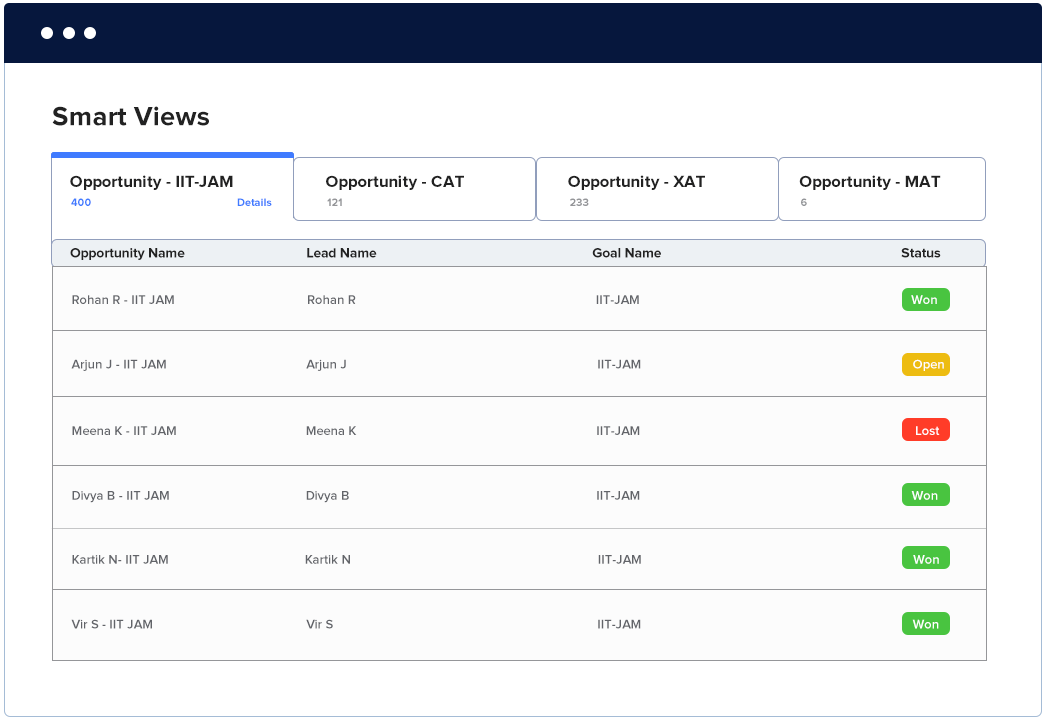
For opportunity management, the CRM suite can prioritize leads. Using data-driven predictions, the CRM will show you which leads you should focus on first. You can track the progress of every lead in the system. It gives you a comprehensive view of all your deals. You can track how much revenue you can expect at closure and which opportunities need immediate attention. It also acts as a central place to store documents, send quotes and invoices, collaborate with your team, and review your sales and marketing efforts using advanced reports.
CRM software, thus, simplifies both lead and opportunity management by bringing them under the same roof.
If you want a one-stop solution to manage leads and opportunities, look no further. Check out LeadSquared Opportunity Management CRM!










